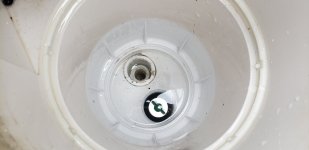Ok, final update... the "righty tighty, lefty loosey" redux was fun but ultimately moot. It was hard to see at first but the plug is definitely glued. So I went with plan B and decided to drill it out.
This was easier said than done because it's hard to reach, and I was really nervous about damaging the rest of the skimmer. I couldn't really get to it from the bottom so I had to drill from the top, and the skimmer is so deep that I couldn't use my hole drilling bits. So I used the biggest bit I had which would reach (a long spade bit, not ideal for plastic bit it did the job) and drilled a hole in the center of the square part. Then I used my
mini saw to carefully cut radius lines out from the center, and a long chisel to knock out as much of the plug as I could. Finally I finished with my 1.5" socket saver bit to round out the opening as much as possible.
Then I glued in a 2" to 1" reducer and tied the 1" into my existing overflow line. I plugged the other hole (the one that goes to the pad) with a rubber plug and tested for watertightness. Finally I removed the block on the skimmer opening and let it drain down into the woods. It took more than an hour to come down but now my water level is right at the bottom of the skimmer opening. We're due for the first big snowstorm of the season this week, and I'm happy that the cover isn't already submerged... and as the snow melts through the mesh, it has somewhere to drain off.
For next summer: I thought about putting in a valve, but instead I decided that I'll just plug the 1" opening from inside with a smaller rubber plug when the time comes. I can always add a ball valve into the 1" line if it's ever needed.





